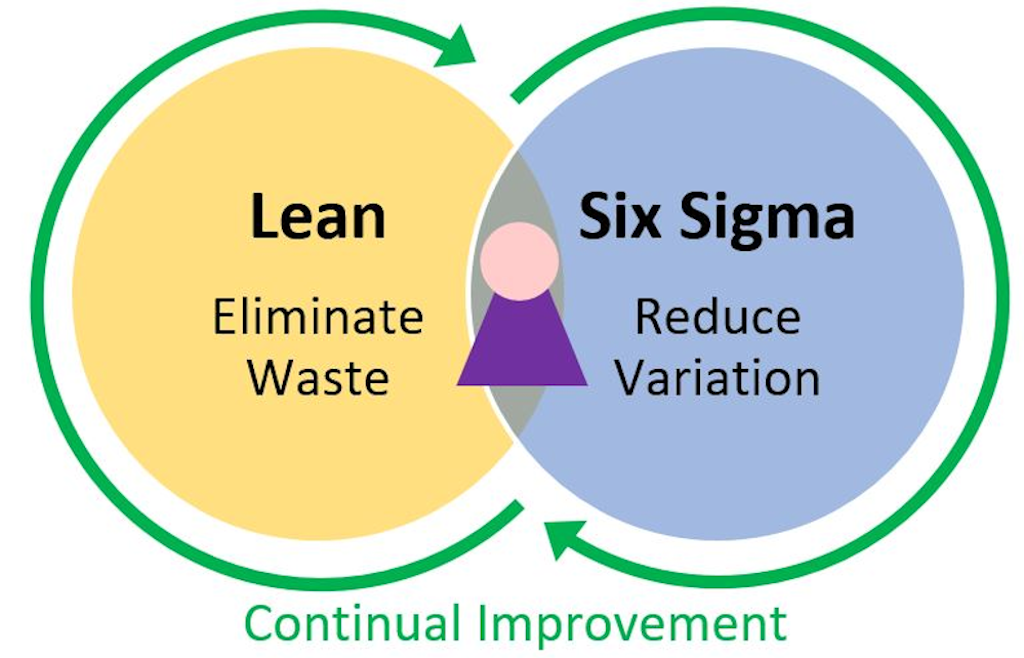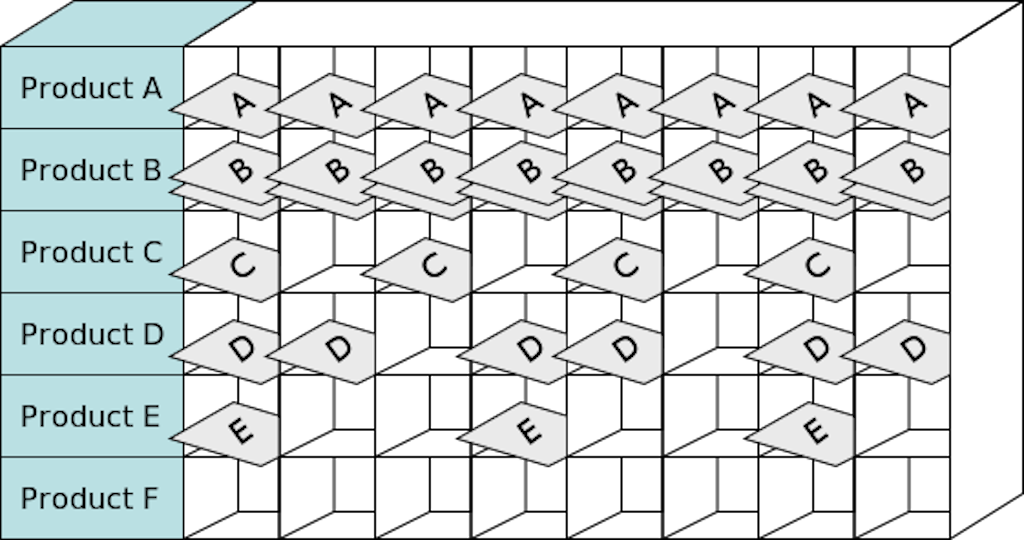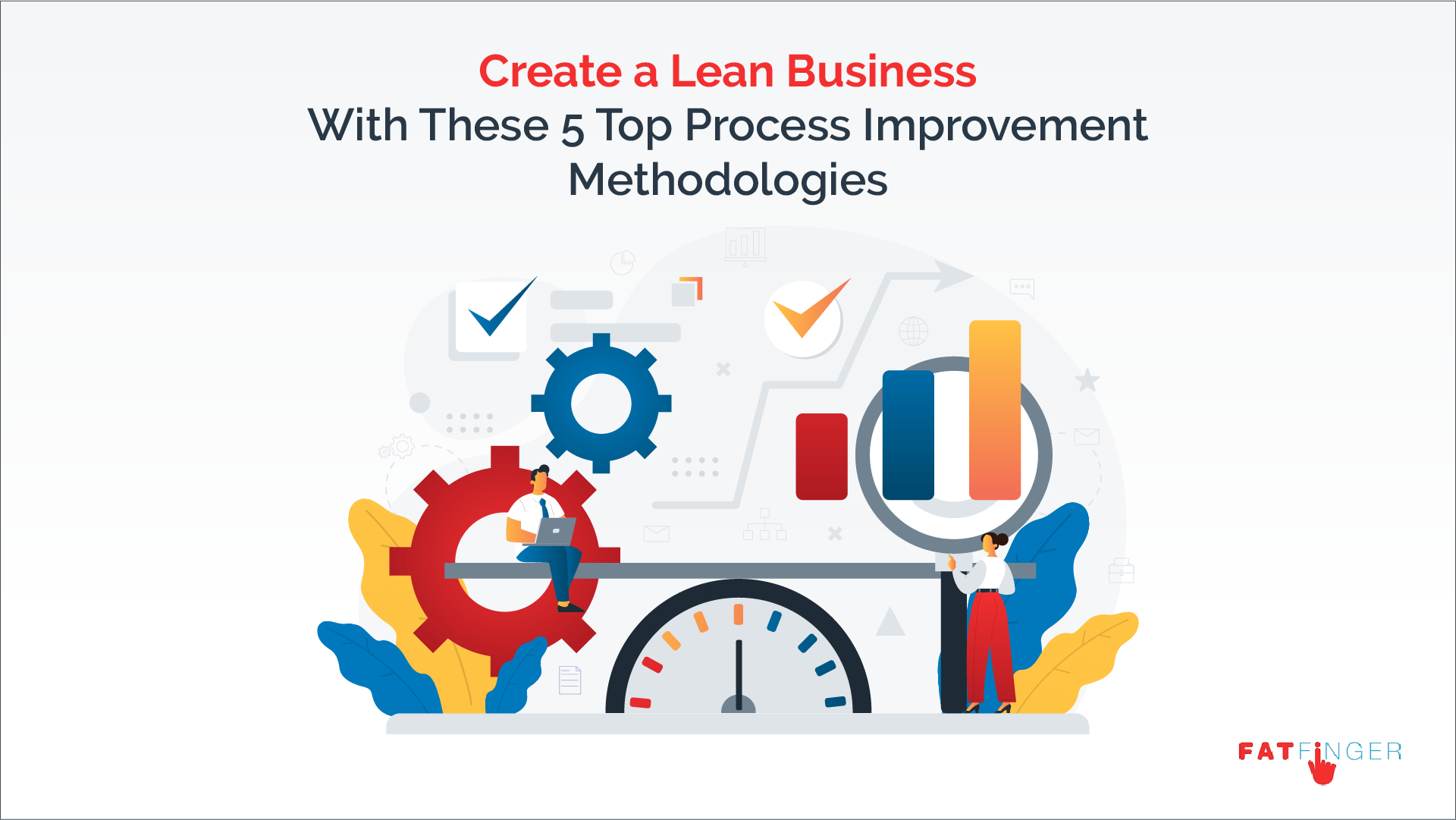“Processes underpin business capabilities, and capabilities underpin strategy execution” – Pearl Zhu, Digital Capability: Building Lego Like Capability Into Business Competency
Our world is changing ever more rapidly. Technological innovations, policy shifts, and the demand for greener operations mean businesses have to be vigilant, adaptable and evolve in response to the constant of change.
In this endeavor, process improvement plays an integral role. Yet process improvement isn’t easy. 50-70% of initiatives fail. For this reason, it’s important to use tried-and-tested methodologies to improve the processes in your business.
With this in mind, in this FAT FINGER article, we present you with our top 5 process improvement methodologies to help you create lean and streamlined business operations. But before that, the article will describe what we mean by business processes, and then explain why process improvement is important.
- What are business processes?
- What is process improvement and why is it important?
- 5 top process improvement methodologies
Let’s jump to it!
What are business processes?
To improve your business processes, you need to understand what they are. A business process is a series of tasks that, when executed in the correct order, deliver the desired business outcome.
For example, consider the steps taken to process an incoming supplier invoice. Organizations have set steps to follow, from receiving the supplier invoice, approving the amount, establishing a remittance date, paying the invoice, and then recording payment in a general ledger. The outcome of this process is a paid, and fully documented invoice.
A business is made up of many business processes. Each process delivers a specific business outcome. These business outcomes, together, enable the smooth running of your organization.
Yet, processes should not be set in stone because the operations they control are fluid. For example, the supplier invoice process just described may need to change in response to supply chain problems. To remain competitive, it’s essential businesses constantly analyze and improve their processes. This means organizations can operate as efficiently as possible, minimizing expenses and maximizing profits.
What is process improvement and why is it important?
Process improvement is the practice of identifying process errors and inefficiencies, analyzing process data, and improving existing business processes for performance optimization.
Think of process improvement as essential business maintenance. Just like you would take your car to the garage for a service, process improvement is the service your business regularly needs to remove blockage and gunk. Without this, your business will be sluggish and out-of-date.
With this in mind, the key benefits of process improvements include:
- Improved customer satisfaction: 54% of process enhancement results in an increase in customer satisfaction as business processes are adapted to meet the customer’s continuously changing needs.
- Saved money: Making process improvements can save you money. For instance, Triaster astoundingly saved over $400,000 per year by improving just 1 process.
- Strengthened customer retention: Having a well-structured onboarding process can boost customer retention by 58%.
- Reduced business costs: 46% of companies see business processes, and their improvement, as a primal key way to reduce business costs.
Yet, process improvement isn’t all that easy. As already mentioned, ~50-70% of initiatives end in failure. There are three main reasons for this failure:
- Not getting support from senior management
- Failure to get employee buy-in
- Failing to adopt a culture of continuous improvement
Organizations need tried-and-tested business process improvement methodologies to prevent these failings. In this FAT FINGER article, we give you our 5 top process improvement methodologies to create lean and efficient processes that can be adjusted to evolve continuously.
5 top process improvement methodologies
A methodology is a specific procedure or technique used to identify, select, process, and analyze information.
The below process improvement methodologies are not definitive, for certain types of processes and organizations, some methods will work better than others. For the best results, we recommend you combine different methods.
Methodology #1: Plan, Do, Study, Act (PDSA)
The Plan, Do, Study, Act (PDSA) is an extensive method of analysis and reflection. This method employs the principle of continuous development – it’s a never-ending cycle. Otherwise known as the Deming cycle, this continuous quality improvement model uses a logical sequence of four stages:
- Stage 1, Plan: You need a plan to understand what you want to achieve. This will guide the development of your end goals. This planning stage is both an attempt to improve your outcomes and a scientific investigation of your business process capacity. Think about what is currently going wrong in your process.
- Stage 2, Do: At this stage, it’s time to implement the changes you deem necessary. Instead of deciding to make a change, and then suddenly overhauling all operations, bring about changes slowly.
- Stage 3, Study: The study stage is a key point of the PDSA cycle. It’s here you analyze the effectiveness of the changes implemented. Has your process improved? But also think about whether the process has improved as you thought it would. Were you able to predict the changed outcomes in advance?
- Stage 4, Act: During the Act stages, you need to implement the recommended changes, track performance, and data over time, and provide the necessary documentation to the company to improve the internal theory. Now you’ve learned that output can be raised by doing action X, you want to do action X in each relevant department.
Methodology #2: Lean Six Sigma

Lean Six Sigma gives a structured approach to scrutinize business operations, meaning individuals can look at data and processes to identify and remove waste.
It’s possible to implement the lean Six Sigma methodology using the DMAIC approach. This is a 5-stepped model, and the steps are named as follows: Define, Measure, Analyze, Improve and Control.
Lean Six Sigma and DMAIC focus on data collection and analysis to improve business operations. The letters in the acronym represent the five stages that make up the improvement process.
- Define: Define the problem and your goal (where you want to be). Next, lay out a project that will address this problem, taking into account the customer requirements. Make sure to set the project boundaries and don’t make the project too broad.
- Measure: You need a benchmark to compare where your process is currently operating relative to what the process performance woud be once improvements have been made. Develop a data collection plan for the process, Obtain data from many sources to determine defect type, and compare customer survey results to identify process shortfalls.
- Analyze: Analyze the data collected to determine the root cause of defects and identify opportunities for improvement. Your aim is to look for gaps between your current performance and goal performance. Using this gap analysis, prioritize opportunities to improve and identify sources of variation.
- Improve: Improve the target process by designing creative solutions that will fix the issues and prevent the issues from reoccurring in the future.
- Control: Control the improvement to keep the process on the new course. You don’t want your processes reverting to the old way.
Methodology #3: Kanban

Kanban is a work management system, often used in industrial processes, that identifies where work gets stuck or blocked. It’s a lean methodology that communicates what, when, and how much of something is needed for optimum production using tools such as Kanban boards and task cards. Kanban addresses bottlenecks and waste by basically balancing the demands of a process against its capacity to handle them.
A Kanban board is used by team members to visualize work items within a process.
You can produce a Kanban board and apply the Kanban methodology by completing the following steps:
- Break down the business process into distinct steps, from the moment the work has started, to the moment the work is complete. This will help you visualize how each step works together in the process.
- Identify the types of work you do and distinguish these tasks using a color key.
- Next, note down each job you’re working on and which step in the given process you are at. The order you note your jobs down in each column of the Kanban board represents their relative priority. You want the most urgent jobs on top.
- Start completing the tasks on your Kanban board. Begin by completing the tasks at the top of the Kanban board. Once these are complete, move on to the task in the next column. This method of working through the Kanban board will facilitate an efficient flow of work.
Methodology #4: Heijunka
Heijunka is a Japanese term meaning leveling. Heijunka helps organizations match unpredictable customer demand patterns to eliminate process waste. Heijunka does this by teaching users to establish a continuous flow of work, to stop processing work in batches by ordering and producing only what’s in demand. The aim is to keep inventory costs low.
The Heijunka and the Kanban methodologies avoid batch ordering, reduce waste and finished goods inventories, reduce capital cost and production lead time, and eliminate unevenness in workload and intensive work. And again, like Kanban, the Heijunka methodology is a process improvement method more commonly applied to manufacturing industries.
Heijunka offers two ways of leveling production:
- Leveling by volume: Production is leveled by the average volume of orders received. For instance, if your average demand is 20 orders per week, but that number fluctuates by the day (e.g. 3,10,5), implementing Heijunka will level production by the weekly volume average.
- Leveling by type: Heijunka is applicable when you’re managing a portfolio of products as well. You can level production based on the average demand for each product in the portfolio and organize your work around it. The principles stay the same, in that you need to create enough of each product to meet the customer’s average demand for that product. Because things start to get more complex as you introduce more products, the Heijunka box is implemented to simplify the process.

The Heijunka box looks like a grid and shows the type of product and the amount of that product that needs to be produced for each day of the week. The horizontal row represents each product in the product portfolio, while the vertical columns are dedicated to each day of the workweek.
Methodology #5: SIPOC diagram
SIPOC is an acronym for Suppliers, Inputs, Processes, Outputs, and Customers.
The SIPOC methodology acts as a tool to summarise the inputs and the outputs of target business processes. The aim is to determine the whole process at the outset and so establish clear boundaries for the process. Building on this last point, SIPOC is typically employed at the Measure phase of the Six Sigma DMAIC methodology. But it is also used to analyze and understand the different processes within a working system.
The SIPOC methodology is particularly useful when it’s not clear:
- Who supplies inputs to the process?
- What specifications are placed on the inputs?
- Who are the true customers of the process?
- What are the requirements of the customers?
This information is communicated using the SIPOC diagram. The purpose of the SIPOC diagram is to identify the overall processes in a working system and to provide an overall perspective. SIPOC supports the definition, structuring, and scoping of complex work systems. SIPOC also highlights problems or weaknesses in a process.
To help you create a SIPOC diagram we’ve detailed the steps below:
- Supplier: Identify who the suppliers are, and the persons, machines, and departments involved in a process.
- Input: What are the required inputs? This includes the material used, the data, workforce, and knowledge needed to run the process.
- Process: What is the process? Identify the process start and endpoint.
- Output: What are the expected outputs? Identify the product, yield, and information.
- Customer: Who are the different customers served at each output?
To learn more about SIPOC, read: SIPOC: How to Easily Define, Map, and Understand Essential Business Processes
Take process improvement to the next level using FAT FINGER
To improve your business processes, you have to know your business processes. Knowing a process means documenting the process steps for full transparency over:
- Who is responsible for each step
- When each step is due and the order the steps are run in,
- What tasks are required to complete each step
Process documentation is easy with FAT FINGER’s drag-and-drop checklist builder. Document your business processes as checklists. From here, you can easily visualize your processes for improvement.
Because FAT FINGER stores your business operations in the cloud, these processes are easily adapted, changed, and improved at a click of a button. The updated processes are then available instantaneously in the cloud, to be accessed by anyone in your team. This means entire teams can follow the new-improved processes in seconds.
For more information on FAT FINGER, and how we can help you create efficient, lean, and adaptable business operations, watch the below video.
Sign up for your free FAT FINGER account and start documenting and improving your business processes today. If you need help getting started, why not browse our extensive workflow library.


